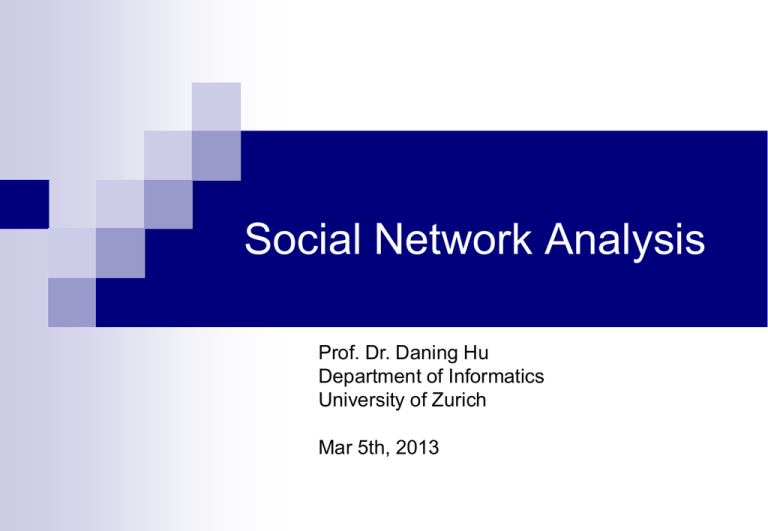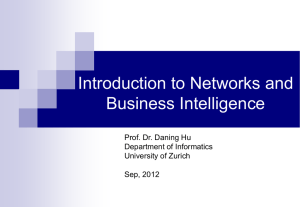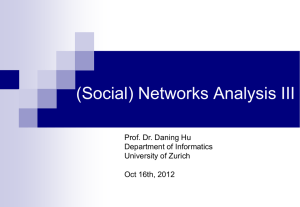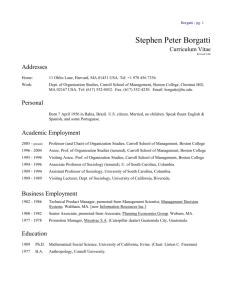Lecture2
advertisement

Social Network Analysis Prof. Dr. Daning Hu Department of Informatics University of Zurich Mar 5th, 2013 Outline Node Level Analysis Link and Group Level Analysis Network Level Analysis Network Topological Analysis Ref Book: Social Network Analysis: Methods and Applications (Structural Analysis in the Social Sciences) http://www.amazon.com/Social-Network-Analysis-ApplicationsStructural/dp/0521387078 2 What is a Network? Node: Any entity in a network (person, system, group, organization) Tie/Link: Relationship or interaction between two nodes. Network Topological Analysis Vs. Dynamic Network Analysis Topology (from the Greek τόπος, “ place ” , and λόγος, “study”) is a major area of mathematics concerned with the most basic properties of space, such as connectedness. as a field of study out of geometry and set theory, through analysis of such concepts as space, dimension, and transformation. Network topology is the arrangement of the various elements (links, nodes, etc). Essentially, it is the topological structure of a network. Physical topology refers to the placement of the network's various components, including device location and cable installation; while logical topology shows how data flows within a network, regardless of its physical design. Node Level Analysis: Node Centrality Node Centrality can be viewed as a measure of influence or importance of nodes in a network. Degree Betweeness the number of links that a node possesses in a network. In a directed network, one must differentiate between in-links and out-links by calculating in-degree and out-degree. the number of shortest paths in a network that traverse through that node. Closeness the average distance that each node is from all other nodes in the network Node Level Analysis: Degree Centrality From Steve Borgatti Node Level Analysis: Betweenness Centrality From Steve Borgatti Link Level Analysis: Length and Distance Length of a path is the number of the links Distance between two nodes is the length of shortest path (i.e., geodesic) 8 From Steve Borgatti Group Level Analysis: Cutpoints and Bridge From Steve Borgatti The Strength of Weak Tie (Granovetter 1973) Strong ties create transitivity Two nodes linked by a strong tie will have mutual acquaitances Ties that are part of transitive triples cannot be bridges Therefore, only weak ties can be bridges the value of weak ties!! Strong ties embeded in tight homophilous clusters, while weak ties connect to diversity Weak ties is a major source of novel information Network Level Analysis: Cohesion Network Topology Analysis takes a macro perspective to study the physical properties of network structures. Network topological measures include: Size, i.e., number of nodes and links Network Cohesion Average Degree, Distance Average Path Length: on average, the number of steps it takes to get from one member of the network to another. Diameter Clustering Coefficient: a measure of an "all-my-friends-know-eachother" property; small-world feature 11 Network Level Analysis: Cohesion Fragmentation: Percentage of unreachable from each other. pairs of nodes that are Calculated as 12 Network Level Analysis: Cohesion Density: the percentage of the number of links over all possible pairs of links. From Steve Borgatti 13 Network Level Analysis: Cohesion Average distance: average distance between all pairs of nodes. From Steve Borgatti 14 Network Level Analysis: Structural Holes 15 Network Level Analysis: Structural Holes 16 Network Topological Analysis Network topology is the arrangement of the various elements (links, nodes, etc). Essentially, it is the topological structure of a network. How to model the topology of large-scale networks? What are the organizing principles underlying their topology? How does the topology of a network affect its robustness against errors and attacks? Network Models Random graph model (Erdős & Rényi, 1959) Small-world model (Watts & Strogatz, 1998) Scale-free model (Barabasi & Alert, 1999) 18 Random Networks Erdős–Rényi Random Graph model is used for generating random networks in which links are set between nodes with equal probabilities Starting with n isolated nodes and connecting each pair of nodes with probability p As a result, all nodes have roughly the same number of links (i.e., average degree, <k>). 19 Random Networks In a random network, each pair of nodes i, j has a connecting link with an independent probability of p This graph has 16 nodes, 120 possible connections, and 19 actual connections—about a 1/7 probability than any two nodes will be connected to each other. In a random graph, the presence of a connection between A and B as well as a connection between B and C will not influence the probability of a connection between A and C. 20 Random Graphs (Cont’d) Average path length: L ~ ln( n ) ln( k ) Clustering coefficient: C p k n Degree distribution Binomial distribution for small n and Poisson distribution for large n Probability mass function (PMF) p (k ) e k k k k! 21 However, real networks are not random! Small-World Network Social networks usually are small world networks in which a group of people are closely related, while a few people have farreaching connections with people out side of the group Starting with a ring lattice of n nodes, each connected to its neighbors out to form a ring <k>. Shortcut links are added between random pairs of nodes, with probability ф (Watts & Strogatz, 1998) Watts-Strogatz Small World model large clustering coefficient high average path length 22 Small-World Networks A small-world network is defined to be a network where the typical distance L between two randomly chosen nodes (the number of steps required) grows proportionally to the logarithm of the number of nodes N in the network, that is: and Lsw Lrand Clustering coefficient: Csw >> Crandom Thus, small-world networks are characterized by large clustering coefficient, small path length relative to n. Degree distribution Similar 23 to that of random networks Scale-Free (SF) Networks: Barabási–Albert (BA) Model “Scale free” means there is no single characterizing degree in the network Growth: starting with a small number (n0) of nodes, at every time step, we add a new node with m(<=n0) links that connect the new node to m different nodes already present in the system Preferential attachment: 24 When choosing the nodes to which the new node will be connected to node i depends on its degree ki Scale-Free Networks (Cont’d) The degree of scale-free networks follows powerlaw distribution with a flat tail for large k p (k ) ~ k Truncated power-law distribution deviates at the tail p (k ) ~ k 25 e k Evolution of SF Networks The emergence of scale-free network is due to Growth effect: new nodes are added to the network Preferential attachment effect (Rich-getricher effect): new nodes prefer to attach to “popular” nodes The emergence of truncated SF network is caused by some constraints on the maximum number of links a node can have such as (Amaral, Scala et al. 2000) 26 Aging effect: some old nodes may stop receiving links over time Cost effect: as maintaining links induces costs, nodes cannot receive an unlimited number of links Network Analysis: Topology Analysis Topology Average Path Length (L) Random Graph L rand ~ Small World (Watts & Strogatz, 1998) Scale-Free network ln N ln k Lsw Lrand LSF Lrand Clustering Coefficient (CC) Degree Distribution (P(k)) Poisson Dist.: CC rand k N CCsw CCrand P (k ) e k k k k! Similar to random graph Power-law Distribution: P(k) ~ k- k : Average degree 27








